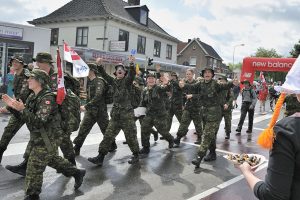Blisters and bliss, military marchers brave Nijmegen
By Lookout on Aug 27, 2012 with Comments 0

Team MARPAC during the 2012 Nijmegen Marches cheers with the crowd as they march through the streets of Groesbeek, Netherlands, during day three of the four-day marches.
It was blisters and bliss for the Maritime Forces Pacific (MARPAC) contingent when they marched in one of the world’s largest annual pilgrimages.
From July 17 – 20, MARPAC’s team joined more than 45,000 military marchers from around the world for the 96th annual Nijmegen March held in The Netherlands.
“It was definitely physically challenging for everyone,” said Lt Pam Harris, MARPAC Nijmegen 2012 team leader. “Even with all the training we did it really took a toll on my body doing four days marching that pace.”
Each day marchers strapped on a rucksack loaded with 10 kilograms of sand, laced up their combat boots, formed up, and marched, while singing songs to take their minds off the aches and pains.
The route was different each day, but always led back to the small village of Nijmegen where the march began in 1916.
“It was initially a military incentive to keep military members in shape and was started by the Dutch, but it is now more geared to honour military members who helped liberate that area of Holland during the war,” said Lt Harris.
Each night back at the camp marchers soaked their feet, tended to their blisters and prepared for the next day.
“We would march for about eight hours a day,” said Lt Harris. “No one complained and everyone interacted with the kids and civilians we met along the way. The team spirit and morale was great. I was very proud of our team. They were amazing.”
Nijmegan veterans CPO2 Chris Koblun and Sgt Kim Arnold went as sweepers, supporting the Canadian and British teams when they needed motivation towards the finish line.
Day three proved the most challenging due to all-day rain that saturated the marchers’ boots and socks.
On day four they found it exhilarating to be cheered on by thousands of people for the final few kilometres.
“Civilians lined the streets to cheer us on. There were literally thousands of people lined up from the streets to the buildings, and some were hanging out of windows. There wasn’t any space left to stand for kilometres,” said Lt Harris. “They really love the Canadians because of our part in the liberation of Holland.”
After the march was over most members had time to explore Holland and other parts of Europe before returning to Esquimalt.
The event annually draws more than 40,000 marchers from 50 different nations and is witnessed by more than one million spectators along the 160 kilometre route.
During the Second World War, Canadian soldiers liberated the area around Nijmegen, and there is a large Canadian military cemetery in nearby Groesbeek. It serves as the final resting place for over 2,300 Canadian soldiers and airmen. The cemetery is on the route of the third day of the March, and all military marchers halted there to pay their respects and conduct remembrance services
Shelley Lipke, Staff writer
Filed Under: Top Stories
About the Author:





